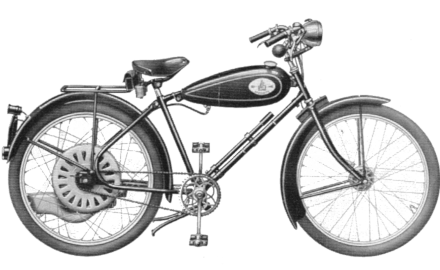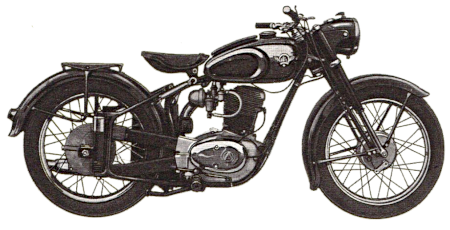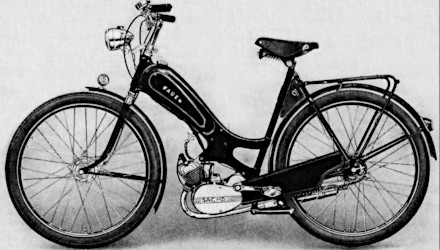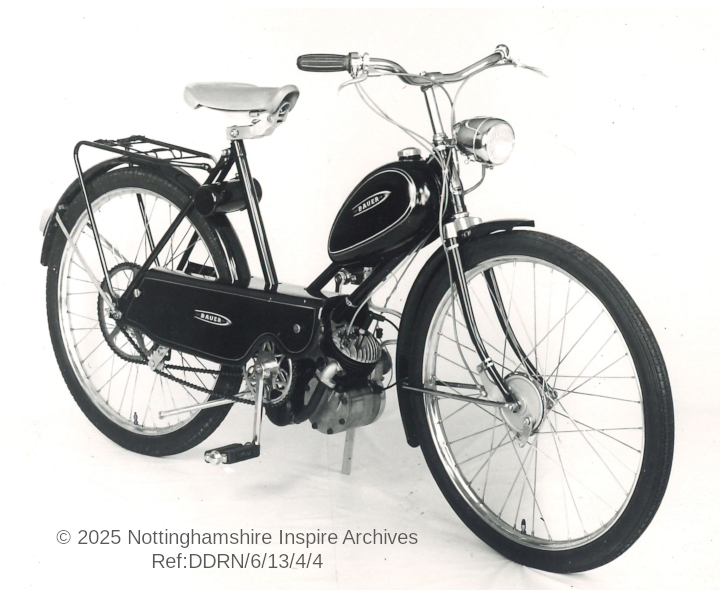In 1911, Ludwig Bauer founded a small metal process and stamping shop to produce heating and lighting fixtures. In the autumn of 1914 the company, with its workforce of three employees, relocated to Klien-Auheimin near Hanau, at which time the manufacture of carbide table lamps was its main product.
After World War I, Bauer Werke started manufacturing bicycle lamps, which developed into the production of complete bicycles by 1922, and over the following years Bauer cycles gained recognition in professional cycling through company rider promotions.

Bauer Saxonette
At the end of 1930 Fichtel & Sachs delivered the first 74cc Saxonette motor wheel engines to Bauer, which were early cyclemotors for fitment into Bauer cycles. Quantities however were small, so only low volume production was possible. In 1936 it was decided to expand the production programme, which included all kinds of bicycles, lighting systems for cycles and motor cycles, cycle trailers and sidecars, plus new 98cc Sachs-powered two-speed MF autocycles and a light motor cycle model.
The autocycles were offered with a gent’s crossbar frame at 315 Reichsmark and a lady’s step-through frame at 327ℛ︁ℳ︁. The B100 light motor cycle had a 98cc Sachs two-speed kickstart motor with footrests in a low-design frame, which was possible because it did not have to accommodate pedal arcs. Black paintwork was the standard finish, though other colours were offered. Optional extras included 8ℛ︁ℳ︁ for a chrome-plated tank, 11ℛ︁ℳ︁ for an electric horn, and 16.5ℛ︁ℳ︁ for a speedometer set.
A 60cc Saxonette joined the range in 1938, but all models were suspended in 1940.
Shortly after the currency reform on 21 June 1948, Bauer launched a new B98/2 motor cycle onto the market, which was available with a Sachs or an Ilo engine. The bike was initially equipped with a conventional girder fork, until Bauer became the first German factory to develop its own telescopic fork for motor cycles, and offered it in the B98/2.
Appreciating a demand for motor cycles in 1949 Bauer presented another new B100 Sachs 98 model for 1950, followed by further two-stroke motor cycles of 123, 147 and 174cc with Sachs and Ilo engines.

1952 Bauer B250
In 1952 a new 248cc overhead-valve, single-cylinder B-250 motor cycle of Bauer’s own design and manufacture was introduced; this had a rear facing exhaust valve port and carburettor. This engine, however, proved problematic as the arrangement was prone to overheating and suffered from a comparatively low power output. They made it for two years in updated model versions with plunger rear & telescopic forks, or later as swing-arm rear suspension & Earles fork, but the development costs led to commercial difficulties and Bauer completely withdrew from all motor cycle manufacturing in 1954.

1954 Bauer B50S
Bauer continued with bicycle production, and shifted all its motorised focus toward the increasingly popular manufacture of mopeds. 1954 sales started with a Lohmann-powered cyclemotor, and B50, B50S, B50R, & Gëpack (Carrier) mopeds with Sachs engines, and all continued in 1955. 1956 models were B50SK, B50SL, and continuation of the Gëpack-Moped. 1957 & 1958 models were B50 Sport, B57, and continuation of the Gëpack-Moped. The 1957 B50 Sport models started introducing a new tank-badge in a rectangular with rounded ends design, which subsequently carried over onto the other models. B57 continued into 1959.
A range of frames was produced in rigid and swing-arm designs as step-through, carrier, and sports styles, variously fitted with rigid, leading-link, trailing-link, and telescopic forks.
Bauer mopeds were reportedly quite competitively priced, carefully crafted, with high quality accessories, and proved that it was also possible to work economically with manual production in smaller quantities.
We could not find convincing evidence that Bauer had continued to manufacture or list its mopeds into the 1960s, however, they may have been looking at another option…

This was another little ‘something’ we found among the Raleigh files at Nottinghamshire Inspire Archives, and on a spur-of-the-moment impulse, thought we might want to look into it.
Based on the single left-hand handlebar brake lever, the engine appears to be a direct drive Sturmey–Archer, mounted in the Raleigh RM1 frame, and utilising the Sturmey–Archer rear hub, beyond which the rest seems to be of other origins.
The conclusion is that all other parts were intended to be fitted by Bauer when the bikes were built up in Germany, so would all have been of German origin.
The rigid front fork is different from the RM1, and not even in the Raleigh style as it doesn’t have the tubular crown, so we presume that Bauer would have been planning to fit their own make fork set. The front brake isn’t Sturmey, and counts 36 spokes, so we suspect it’s of continental source since that would be more likely for 36-hole hub. It looks as if the wheel & tyre size might be 26 × 2 × 1¾ with 22½" Westwood pattern rims instead of the RM1’s 26 × 2 with 22" Dunlop Endrick pattern rims of 32 holes on the front and 40 holes on the rear.
The Bauer mudguards appear to be more like cycle guards compared with the RM1 guards, the stays to the Bauer guards are also different, and there seems to be a continental style cycle rear lamp mounted on the rear mudguard.
The rear carrier is fitted to brazed-on lugs on the stays, which is a feature that typically appears on Bauer bicycles, but not on Raleigh. Also, some Bauer bikes use the same toolbox position. The chain-wheel isn’t Raleigh, though we’ve not yet found a similar one on any other Bauer bike either…
The side panels are a different pattern from the RM1.
The Amal twist-grip throttle and grips are of the same type as fitted to the Wisp, which adds up since German manufacturers didn’t seem to produce dual-action decompressor–throttle controls as standard. The brake levers don’t look the same as the levers normally fitted to Raleigh mopeds, and would seem more like some other sort of cycle levers.
There is a Bauer badge on the steering headstock.
After much deliberation on the subject of dating, and according to Glass’s Index, the RM1 and RM1c were available side-by-side right up to the end of 1959 when both models were de-listed, and Raleigh’s own advertising does seem to confirm this.
Our dating conclusions are mainly based on the fitment of the tail-pipe exhaust, as a later development replacing the original ‘pepperpot 5-pipe exhaust’ which was reportedly prone to carbon blocking. The tail-pipe silencer appeared at some point following the introduction of the RM1C in May 1959, and there is some suggestion that this improved silencer came in with the RM2C in January 1960, though our library doesn’t have the original Raleigh Service Memoranda to cover this change, so we are unable to confirm this.
On this basis we’re dating the Bauer at 1960.
It looks as if the plan would have been for Raleigh to pretty much just supply the frame, Sturmey–Archer engine, and rear hub set to Bauer, for building up in Germany with their own cycle parts.
Being based on the direct-drive RM1, Bauer might have been considering this model as the cheapest moped that money could buy on the German market. The RM1 was the second cheapest ‘proper’ moped on the British market (the Mobylette Standard was cheaper but selling that as a Bauer in Germany would probably have been problematical). That could also be a reason why it’s based on the RM1 rather than RM1C (clutched) transmission, then it might be advertised at the lowest price, along with the option of ‘for only a few Deutsche Mark more, you can add a clutch’.
As it never seems to have gone beyond a prototype, did Bauer decide not to proceed with this project, or did the TI merger with Raleigh compromise its prospects?
Bauer Werke certainly continued into the 1960s, but the lack of any further motorised references suggests that the brand didn’t list any mopeds for sale in 1960, and there’s no indication that the Raleigh/Sturmey–Archer/Bauer moped ever went into production.
Bauer presumably downscaled back to its core business of bicycles, until filing for bankruptcy on 10 December 1968 and closing its factory gates.
And if you’re wondering what relevance the title might have to this article: Bauer is German for Farmer.


